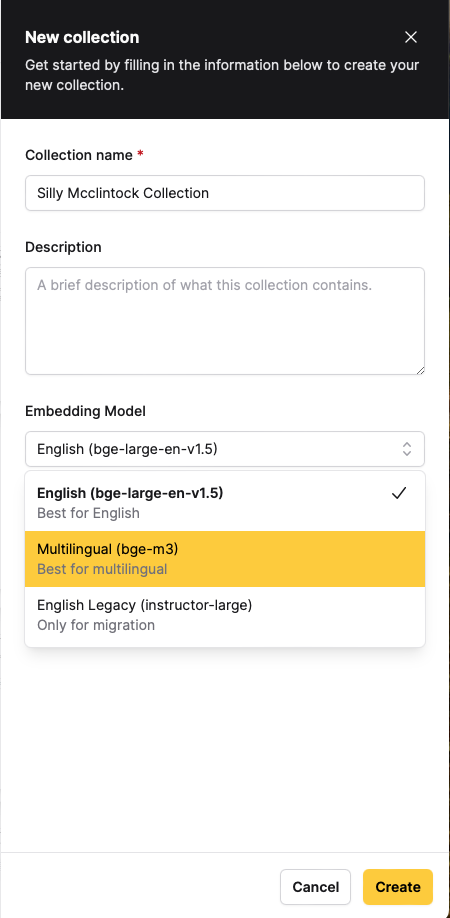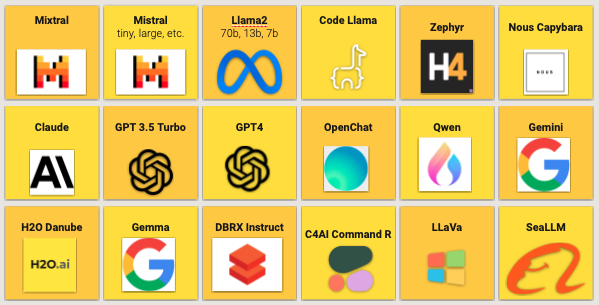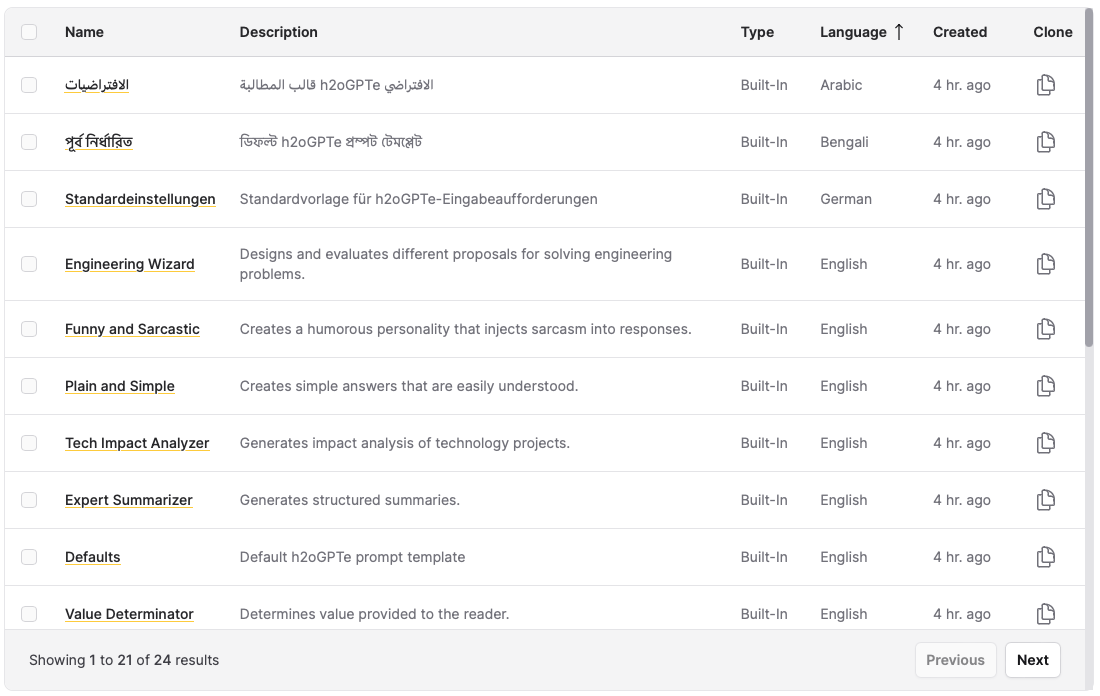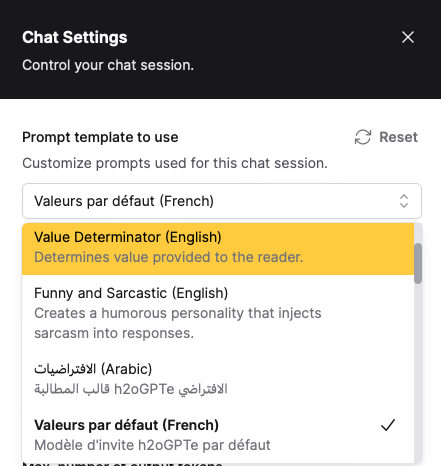What's new in h2oGPTe v1.6.x
We are excited to announce the release of h2oGPTe 1.6! Read on to learn about the new features and improvements in h2oGPTe 1.6.x series that help you find answers and generate content based on your private data.
Overview of the 1.6.x Release
The h2oGPTe 1.6.x series delivers significant capabilities for autonomous AI assistance, enhanced APIs, and improved document processing:
Major features
- Agent functionality: Autonomous tool use with code execution, placing #1 on the GAIA leaderboard for General AI assistants
- Role-Based Access Control (RBAC): Comprehensive permission system for users and groups
- REST API: OpenAPI-compliant interface with auto-generated bindings for Python, JavaScript, and Go
- Custom GPT creation: Collection-based configuration system for tailored AI assistants
Key improvements & fixes across releases
- Updated supported LLMs list: Added coverage of new large language models, including OpenAI's GPT-5 series
(v1.6.37) - OpenAI compatible API: Added OpenAI API compatibility for integration with existing applications, supporting chat completions, responses, and streaming
(v1.6.37) - Exception handling and resilience: Improved exception handling and increased resilience for document ingestion and old parsing issues
(v1.6.35) - Internationalization: Added RTL language support to improve UI compatibility with right-to-left languages
(v1.6.34) - Enhanced mobile experience: Better navigation, responsive design, and improved card layouts
(v1.6.33) - Developer experience: Async API examples, simplified client connections, and enhanced code execution
(v1.6.33) - System reliability: Better error handling, improved self-tests, and enhanced stability
(v1.6.32, v1.6.33) - Performance optimizations: Faster document ingestion, improved chat queries, and streamlined processing
(v1.6.32) - Client stability: Improved real-time chat stability and connection reliability for web applications
(v1.6.40) - Multilingual support: Added translation framework supporting both left-to-right and right-to-left languages and full Spanish language support
(v1.6.41) - Agent capabilities: Added support for selecting user personas when using an agent and a specialized Data Science agent type for advanced analytics tasks
(v1.6.41) - Enterprise security: Secret Manager and Secure Connectors now configurable by administrators for centralized credential management and secure external integrations
(v1.6.43) - Workspaces: Added workspace functionality with tagging and personal workspace migration
(v1.6.43) - Enhanced agents: New Tool Builder Agent and improved agent response UI
(v1.6.43) - New connectors: Added new connector to import content directly from Atlassian Confluence
(v1.6.43) - Improved document management: Added video scene descriptions and auto-tagging with agents
(v1.6.43)
Major patch releases
- Patch v1.6.43 (November 2025)
- Patch v1.6.41 (October 2025)
- Patch v1.6.36 (July 2025)
- Patch v1.6.33 (June 2025)
- Patch v1.6.32 (June 2025)
h2oGPTe v1.6.43
Improvements
Workspaces and organization
- Workspace functionality: Added workspace feature to organize and manage your content with tagging and tracking capabilities.
- Existing personal content automatically migrates to the new workspace system
Agent capabilities and tools
- Tool Builder Agent: New specialized agent type designed for building and customizing tools
- Automatic model routing: Agents now automatically select the best model based on accuracy requirements for optimal results
- Agent monitoring: Added tracking for agent conversation turns to help monitor agent usage
- Final Answer Mode: New dropdown in agent configuration to control how agents deliver final responses
- Agent streaming and files UI: Improved real-time streaming interface and file management for agent responses
- Human-in-the-loop planning: Added control to review and approve agent planning before execution
- Document auto-tagging: Agents can now automatically tag documents using specialized tools
- Tool defaults: Option for admins to enable tools by default when creating new agents for faster setup
- Authentication improvements: Improved authentication tab interface for configuring agent credentials
New model support
- Google Vertex AI Gemini 2.5 Pro: Added support for Google's latest Gemini model via Vertex AI
- GPT-5 Codex: Added support for OpenAI's GPT-5 Codex model
Document processing and connectors
- Video scene descriptions: h2oGPTe now generates automatic scene descriptions for better understanding of video content
- Auto-Sync Collection Connector: New connector that automatically synchronizes collections with external sources
- SharePoint OAuth2 authentication: Enhanced SharePoint connector with OAuth2 user authentication for improved security
User interface and experience
- Clickable table links: Tables now support clickable links for better navigation
- Microphone animation: Added visual animation when microphone is active during voice input
- Chat session creator: Users can now see who created each chat session on chats and collection pages
- Shareable extractors: Extractors page can now be shared with other users
- Collection application: Improved interface for applying collection settings in chat sidebar
- Chat with specific collection: Added ability to start a chat directly with a specific collection
- Document deletion: Users can now delete documents from collections when they have proper permissions
Privacy and security
- Custom PII detection: Added AI-powered detection for user-defined personal information labels
User experience refinements
- Global settings discoverability: The global settings are now under System Settings tab for easier access
- Action menus on inactive chats: Added action menu buttons for archived or inactive recent chats
- Searchable user dropdowns: User selection dropdowns now support search for easier user finding
- Searchable model options: Model selection dropdowns now support search functionality
- Dark mode improvements: Fixed font color issues in dark mode for better readability
- Android voice improvements: Enhanced speech synthesis for Android webview users
- Role selector: Added role selector to the side menu in the user interface.
Interface improvements
- Disabled input when recording: Text input automatically disabled when microphone is active to prevent conflicts
- Title truncation: Long titles are now automatically truncated with ellipsis for cleaner display
Performance improvements
- Faster collection loading: Reduced API calls for collections and documents, resulting in faster page loads
- Better document retrieval: Markdown and HTML content now processed more effectively for improved search and retrieval
Bug fixes
User interface
- Layout fixes: Fixed padding and spacing issues in primary and secondary panels
- Code viewer: Removed width restrictions on code viewer for better code display
- File status badges: Fixed positioning of file status badges
- Height issues: Resolved height calculation problems in various interface components
- Markdown tables: Improved handling of edge cases in markdown table rendering
- UI crash prevention: Fixed crash that occurred when no language models were configured
h2oGPTe v1.6.41
Improvements
User interface and experience
- Spanish language support: Added full Spanish language localization throughout the user interface
- Language-specific voice: Text-to-speech now automatically speaks in the language you've selected or the language of your prompt template
- Collection sharing: Added share button on Collections page to easily share collections with team members
- Prompt sharing: Added share button on Prompts page to share your custom prompt templates with team members
- Share dialogs redesign: Improved sharing dialog box for collections and prompts with clearer options and better layout
- Chat session expiration: Added ability to set expiration dates for shared chat sessions for better security control
- Document filtering: Added toggle to switch between viewing all documents or only your own documents
- Document references: Document links now display their source location for easier identification and navigation
- WebP image support: You can now upload and view
WebPformat images in your collections - Mobile menu: Fixed navigation menu glitch on mobile devices for smoother browsing
- Table display: Fixed table width issues to ensure consistent display when resizing your browser window
- Toggle controls: Resolved toggle button width issues for more consistent appearance
- Status updates: Fixed real-time status updates on cards and tables to display changes immediately
- File information: Fixed display of file names and sizes to show complete information
- Collection previews: Resolved issues with document preview displays in collections
- Markdown links: Fixed issue where clickable links were being removed from formatted text responses
- Chat formatting: Chat responses now maintain proper formatting after sensitive information removal
Agent capabilities and personalization
- Data Science agent: Added a new agent type designed for data analysis, statistics, and analytics workflows
- User Persona selector: Added dropdown in Configuration panel to select your role or persona for more tailored responses
- Custom Tools framework: Administrators can now create, build, and deploy custom tools for specialized tasks
- Tool filtering: Added filter dropdown in agent tools table to find tools by type
- Browser navigation: Added new tool that allows agents to browse and interact with web pages
Administrator features
- Secret Manager panel: Administrators can now manage all API keys and credentials from a centralized, secure admin panel
- Default prompts: Administrators can customize default prompt templates for your organization
- Output token limits: Added global setting to control maximum response lengths for cost management
- API key expiration: Administrators can set automatic expiration dates for API keys
- Role customization: Administrators can configure custom role settings visible via System Dashboard
Performance improvements
- Faster document processing: Documents are now indexed faster through concurrent processing
- Improved page rendering: Pages with complex formatted text now load faster
- Smoother email handling: Email documents now display more quickly
Bug fixes
Security
- Session security: Improved protection against unauthorized session access
- Security vulnerabilities: Addressed security vulnerabilities
CVE-2025-22874andCVE-2025-4565
Stability
- Document storage: Resolved timing issues between database operations
- Database Operations: Improved handling of database connection issues for more stable operation
- System cleanup: Improved cleanup processes to prevent resource buildup over time
h2oGPTe v1.6.36
Improvements
User interface and experience
- Prompt templates: Added prompt template group sharing functionality
- Document management: Fixed manual document tag creation
- Document browsing: Resolved pagination limit issues when browsing documents
- Desktop filters: Adjusted document filters minimum width to prevent layout overflow
- File upload: Improved ingestion dialog appearance and user experience
- Banner support: Added configurable banner functionality for system administrators
Security and authentication
- User permissions: Fixed issue where users could assign shared keys from other users, now properly limited to admin shared keys
- Guest authentication: Improved guest user fingerprint handling as subject identifier
- Token exchange: Enhanced token exchange for JavaScript RPC client with performance optimizations
System administration and configuration
- Settings management: Improved settings with automatic updates and better performance
Performance and scalability
Processing optimizations
- Concurrent processing: Improved handling of concurrent requests for better throughput
- Image processing: Added support for non-A4 format pictures with proper fitting
Backend improvements
- MCP enhancements: Upgraded Model Context Protocol (MCP) with various improvements
- Browser automation: Updated Puppeteer for improved browser-use support
Bug fixes
Agent functionality
- Environment variables: Improved agent environment variable handling for better reliability
User interface
- Document tags: Resolved manual document tag creation problems
- Collection sharing: Enhanced collection sharing functionality with proper access controls
Documentation improvements
- System administration: Enhanced documentation for system administration and configuration features
Model and integration updates
h2ogpt updates: Multiple h2ogpt version updates with various improvements and fixes
h2oGPTe v1.6.33
Improvements
User interface and mobile experience
- Collection management: Fixed collection count display when filtering through search, ensuring accurate result counts
- Error messaging: Enhanced error messages for administrators who lose access to private collections
- Card layouts: Improved username display in card views with cleaner text formatting and responsive design for mobile devices
- Mobile navigation: Better menu handling and responsive design for smaller screens
- Code rendering: Enhanced prompt code block rendering with syntax highlighting headers and improved formatting
API and developer experience
- Documentation: Added comprehensive async API examples covering authentication, document management, and chat operations
- Code execution: Enhanced agent tool detection for Python and shell code blocks, expanding supported programming languages
Bug fixes
System stability
- Error handling: Improved UI reliability and stability
- Agent sessions: Enhanced error handling for agent chat sessions to reduce failure rates when restarting messages
User interface
- Fixed cursor navigation issues in code blocks for keyboard users
- Resolved mobile button list rendering errors affecting interface stability
- Improved error handling for collection sharing with clearer permission feedback
Backend and API
- Enhanced persistence of collection configuration settings, eliminating page refresh requirements
- Fixed non-streamed REST API response handling for better reliability
Performance improvements
- Enhanced PII (Personally Identifiable Information) detection and redaction with improved accuracy and expanded data type coverage for document processing workflows
- Improved arXiv document downloader reliability for consistent document processing
New model support
New model support in this version:
- Claude 3.5 (Bedrock)
- OpenAI o1 (Azure)
- OpenAI o1-mini (Azure)
- Gemini 2.0 Flash
- Gemini 2.0 Flash Thinking
- DeepSeek V3
- DeepSeek R1
- Qwen/Qwen2.5
- Qwen/Qwen2-VL
- Qwen/QwQ
h2oGPTe v1.6.32
Improvements
Document and collection management
- File management: Added delete option to documents grid view for easier file management
- Collections layout: Enhanced space management and visual layout on Collections page
- Processing speed: Introduced Lite ingest mode for faster, streamlined document processing
User interface and experience
- Mobile usability: Enhanced filter bar on Documents page for improved mobile device usability
- Private mode: Improved UI appearance in private mode
- Notifications: Moved model failure notifications to sidebar alerts to reduce user experience interruptions
- Session management: Enhanced auto-logout logic to prevent premature session terminations
- Localization: Added prompt template for British English to support international users
System administration and configuration
- License flexibility: Added support for older H2O.ai public keys during license checks
- Network configuration: Exposed configurable WebSocket ping timeouts for administrators to fine-tune chat session connections
- Storage optimization: Exposed S3 connection limits for tuning during high-load document ingestion periods
- Feature control: Made web crawl functionality optional, giving administrators control over external website crawling as a RAG (Retrieval-Augmented Generation) ingestion method
Performance and scalability
Processing optimizations
- PDF handling: Resolved slow ingestion speeds for certain PDF documents
- Chat performance: Optimized chat queries for faster, more efficient performance
- Processing reliability: Ensured unique processing paths for per-page PDFs to improve ingestion reliability
- Browser updates: Updated to latest Chromium version for improved performance and security
AI and agent enhancements
- RAG optimization: Enhanced prompt queries to ensure LLMs recognize RAG task performance
- Metadata efficiency: Deduplicated document metadata sent to LLMs for improved efficiency and response quality
- PII detection: Updated PII (Personally Identifiable Information) model and detection threshold
System reliability
Stability improvements
- Service coordination: Enabled sub-services to refresh and register state independently for better system awareness
API and developer enhancements
- Performance optimization: Optimized automatic chat naming feature logic by checking settings before pulling chat history
Bug fixes
User interface and application
- Agent messaging: Fixed bug where new agent chat messages would fail after stopping previous messages in the same session
- Collection integration: Fixed agent chat with collections failing to include RAG context
- Configuration persistence: Fixed collection configuration settings not applying to new chats until page refresh
- API responses: Ensured final responses for non-streamed REST API calls are always returned
- Template sharing: Fixed issue preventing non-owners from sharing prompt templates
- Document references: Ensured most up-to-date document names are used in references
- Page synchronization: Fixed page resynchronization issues after redaction
- Navigation consistency: Fixed back button alignment with page headings across all relevant pages
- UI consistency: Aligned thumbnail picker container appearance with thumbnail card containers
- Message highlighting: Applied correct parsing algorithm for highlighting evaluated chat messages
- User interface: Fixed visibility condition for user pairing link
Backend and API
- API reliability: Improved file type detection for better document processing
h2oGPTe v1.6.0
Released: January 31, 2025
Agent features
Agent overview
The h2oGPTe Agent enables autonomous tool use through code execution. It uses large language models (LLMs) for code generation and reasoning. The agent achieved #1 ranking on the GAIA leaderboard, which measures General AI assistant usefulness.
Key features include:
- Deep Research assistance: Provides autonomous analysis with full transparency into decision-making processes
- Comprehensive output: Delivers analysis summaries, internal chat transcripts, and downloadable artifacts for each conversation
- File management: Gives you access to newly created files (PDF, Excel, PowerPoint) and all code snippets used in document creation
Agent control
You can enable or disable the agent through the chat input interface. The agent operates autonomously based on your prompts and configured prompt templates.
Accuracy Presets control conversation depth and processing time:
- Quick
- Basic (default)
- Standard
- Maximum
Each preset defines the number of conversation turns and maximum processing time per turn.
Agent tools
Administrators can enable or disable these agent tools for chat queries:
Code and Development:
- Aider Code Generation
- Shell Scripting
- Python Coding
Data Visualization:
- Mermaid Chart-Diagram Renderer
- Image Generation
Content Processing:
- Ask Question About Image
- Audio-Video Transcription
- Convert Document to Text
- Screenshot Webpage
Research and Search:
- Google Search
- Bing Search
- Scholar Papers Search
- Wolfram Alpha Math Science Search
- Wikipedia Articles Search
- Wayback Machine Search
- Web Image Search
Document Analysis:
- Ask Question About Documents
- RAG (Retrieval-Augmented Generation) Vision
- RAG Text
System Integration:
- H2O Driverless AI Data Science
- Browser Navigation
- Download Web Video
- Advanced Reasoning
- Evaluate Answer
Network Access:
- Internet Access
- Intranet Access
Access control and permissions
Role-based access control (RBAC)
This version introduces a comprehensive role and permission system. Each role contains specific permissions, and administrators can assign roles to users and groups from federated authentication providers like LDAP.
Available permissions:
Chat management:
- Delete chats
- Submit chat feedback
Collection management:
- Add collections
- Delete collections
- Edit collections
- Make collection public
- Share collections
Document management:
- Add documents
- Delete documents
Template management:
- Delete prompt templates
- Edit prompt templates
- Share prompt templates
System administration:
- Show admin center
- Allow device pairing when configured
- Show extractors
- Show live logs
- Show models page
- Show private button
- Manage roles
- Display system notifications
- Display developer settings
API and developer tools
REST API
A new REST API complements the existing Python RPC client. The API conforms to the OpenAPI standard and provides built-in Swagger UI documentation.
Auto-Generated bindings:
- Python REST API
- JavaScript REST API
- Go REST API
Custom GPT creation
Create custom AI assistants using the formula: Collection + Collection Settings + Default Chat Settings = Custom GPT.
Each collection contains default chat settings that apply to new conversations. You can apply current settings as collection defaults through the Apply current settings as collection defaults button or via API.
Code generation for chat messages
Each chat message displays the equivalent Python client code, enabling developers to replicate queries programmatically.
Model and processing improvements
Reasoning model support
The models page displays reasoning capabilities and shows which reasoning models support non-reasoning models, similar to vision model relationships. Reasoning models work with chat, RAG (Retrieval-Augmented Generation), and agent use cases.
Vision capabilities
Enhanced vision model functionality across the platform.
Document processing
Parsing improvements:
- Layout detection
- Chunking algorithms
- Image captioning
- Text conversion
- Document highlighting
- Excel handling (large tables are summarized while remaining fully accessible to agents for data analysis)
Handwriting recognition
The H2O Mississippi model provides default handwriting-to-text transcription and ships with the platform.
Supported LLMs
Support for proprietary and open-source models includes:
Cloud providers:
- Claude 3.5 (Bedrock)
- OpenAI o1 (Azure)
- OpenAI o1-mini (Azure)
- Gemini 2.0 Flash
- Gemini 2.0 Flash Thinking
Open-Source Models:
- DeepSeek V3
- DeepSeek R1
- MiniMaxAI
- Qwen/Qwen2.5
- Qwen/Qwen2-VL
- Qwen/QwQ
- Llama-3.3-70B
- Llama-3.2-11B-Vision
- Llama-3.2-90B-Vision
H2O Models:
- H2O Mississippi
Performance and scalability
Architecture improvements
- Models Service: Redesigned backend enables horizontal scaling for document ingestion and chat through a dedicated service shared by chat, crawl, and core services
- Auto-Scaling: Optional KEDA-based auto-scaling for the models service
- Database Operations: Parallelized Vex database operations
- Conversion Speed: Accelerated text-to-PDF conversion
User experience enhancements
Interface improvements:
- Separate guardrails and PII (Personally Identifiable Information) settings
- GUI-based custom guardrails configuration
- Enhanced PDF display
- Collection thumbnails
- Improved models page layout
- Better scrolling and pagination
- Syntax highlighting for markdown and code blocks
- Enhanced job cancellation
- Faster automatic RAG type detection
Model testing
Self-Test enhancements:
- Functional self-tests with multimodal RAG and guided JSON
- Better detection of model endpoint configuration issues
Administrative features
White labeling
Customization options include:
- Custom logos
- Color schemes
- Greeting messages
- Personality configuration in prompt templates
Topic modeling
Generate topic model visualizations for any collection with a single click. Visualizations show clusters of similar phrases and concepts, providing content overviews and identifying areas for content optimization.
Collection management
Lifecycle controls:
- Configurable collection expiration times
- Collection size limits
Performance optimizations
- Faster public chat sharing
Security
No critical or high CVEs at the time of release.
Support and resources
For technical support and questions about this release:
Additional resources
Upgrade information
We recommend upgrading to the latest version of h2oGPTe 1.6.x to access these improvements. The upgrade process preserves all your existing data and configurations.
- Submit and view feedback for this page
- Send feedback about Enterprise h2oGPTe to cloud-feedback@h2o.ai



